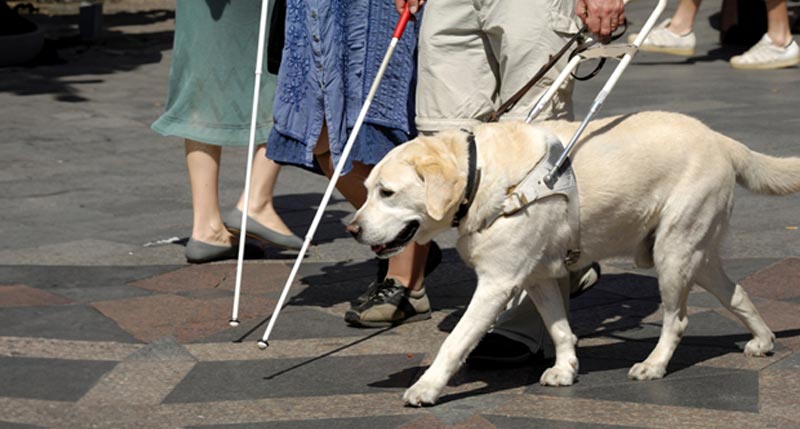Earlier in October, we observed World Sight Day, a global event dedicated to raising awareness about eye health and preventing blindness. For people who have the gift of sight, navigating daily activities like crossing streets, shopping, and reading signs is second nature.
But what if you or a loved one experiences a total loss of vision? For people who are either blind or severely visually impaired, a trained guide dog for the blind can literally transform their lives.
Guide dogs empower the non-sighted population with dignity, independence, and renewed confidence by providing a reliable way that they can navigate the world safely. Though we don’t have an exact count, an estimated 10,000 guide dog “teams” — a guide dog plus their visually impaired handler — are operating today in the United States.
Guide dogs offer not only companionship but also a vital lifeline to independence and mobility. How do these incredible service animals support their handlers, which breeds are best suited to be guide dogs, and how are they trained?
Here are five frequently asked questions about guide dogs for the blind:
- Where are guide dogs trained?
There are 14 guide dog training centers in the U.S. that are accredited members of the International Guide Dog Federation, an organization that makes sure the schools provide their dogs with the best possible care and training.
The U.S. training centers include Guide Dogs for the Blind (the largest), Guide Dogs of America, and The Seeing Eye (the oldest, and the reason guide dogs are sometimes called “seeing eye dogs”). Guide dog training centers are typically non-profit organizations that operate a network of breeders, instructors, donors, and volunteers who help prepare and train highly qualified guide dogs to assist both children and adults.
- What breeds are best for this work?
It is critical that the dogs have the right temperament, intelligence, and size to do the work of guiding a visually impaired person around city streets, inside buildings, and in their home. The most popular breeds of guide dogs are Labradors, Golden Retrievers, and German Shepherds. These skilled canines typically work for 6 to 8 years and then retire between the ages of 8 and 10.
- How much do guide dogs cost?
A fully trained guide dog represents a lot of work, time, and effort. For that reason, they can be very expensive. Though most guide dogs are provided without charge to blind or visually impaired people who need them, the cost for a trained dog would be $40,000 to $60,000 each, with approximately $180 – $220 a month for its care.
Fortunately, volunteers, fundraising, and donations help to cover most or all of those expenses.
- What does guide dog training entail?
Guide dogs undergo a rigorous training process to teach them the skills and behaviors needed to assist their handlers safely in a variety of real-world situations. The intense training takes many months.
First, the dogs are introduced to basic commands like sit, stay, and lay down, and familiarized with wearing their service harness. Next, dogs learn to navigate obstacles and stay focused despite the many distractions they will most definitely encounter. As their training progresses, dogs are tested in new environments and learn “intelligent disobedience,” where they are trained to disobey unsafe commands—such as refusing to cross the street if a car is coming or there is another unsafe scenario their handler can’t sense.
As the dogs continue their training, they are taken into complex settings such as elevators, escalators, and busy outdoor areas. They must learn extremely high levels of obedience and are taught to refuse food offered to them by anyone except their handler. Guide dogs ride on public transportation and undergo vehicle interaction training, which are necessary skills to ensure they can help their handler safely navigate in any situation.
A guide dog’s final exam includes obedience, traffic, sidewalk travel, buildings, and guide work.
After the dog passes all of these tests, the instructor speaks with the dog’s potential match about their particular lifestyle: Do they live in a city or on a country road? Commute by train or bus? Frequent stores or sports arenas? After the interview, extra time is spent training the dog on these specific environments and tasks so the dog is well-suited to succeed in their new home with their new handler.
- What is proper etiquette when interacting with a guide dog?
A guide dog provides more than just assistance for their handler—having a guide dog can mean a blind person’s return to an active, independent, and fulfilling life. Once fully trained, these incredible dogs are able to navigate almost every environment, assisting their handlers in moving safely and confidently through life.
So, how should you act around a guide dog and its handler? When in doubt, just ask the dog owner — most are willing to educate the public on how to interact with their guide dog. But as a general rule:
- Don’t call out the dog’s name or give any commands
- Don’t allow children or pets to interact with the dog
- Don’t feed the dog anything without the handler’s permission
- Don’t attempt to steer, hold, or guide the person navigating the dog
- Do ask permission to pet the dog if it is out of its harness
- Do walk on the handler’s right side—and stay a few paces behind them
For those of us who are sighted, it’s important to remember how much we rely on our vision to experience the world around us every day. Prioritizing eye health through regular checkups with your optometrist is essential to maintaining your independence and quality of life. If you’re due – or overdue – for your annual eye exam, call us today!

